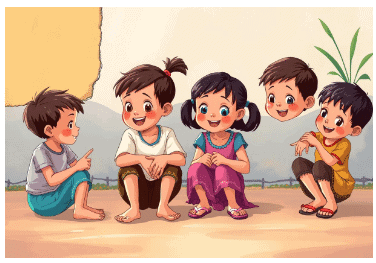Social-Emotional Development Across the Lifespan Chapter Notes | AP Psychology - Grade 11 PDF Download
Introduction
Social-emotional development shapes how individuals interact with others and understand themselves from infancy to old age. This process involves forming attachments, developing identities, and navigating relationships. Early experiences, especially in childhood, significantly influence lifelong social-emotional well-being. Theories like Bronfenbrenner’s ecological systems and Erikson’s psychosocial stages provide frameworks for understanding these dynamics, while factors like parenting styles, peer relationships, and adverse childhood experiences (ACEs) play critical roles in developmental outcomes.
Ecological Systems Theory
Bronfenbrenner’s theory illustrates how various environmental layers influence development, with each system representing a different level of social impact.
Microsystem: Direct contact groups with immediate influence.
- Family dynamics at home.
- Peer interactions at school.
- Religious or community group involvement.
- Sports team participation.
- These interactions directly shape daily experiences and growth.
Mesosystem: Connections between microsystem elements.
- Parent-teacher communication affecting academic success.
- Coordination between parents and coaches influencing athletic growth.
- Interactions between different peer groups.
- These links create consistency or tension across environments.
Exosystem: Indirect environmental factors.
- Parental workplace policies affecting family time.
- School board decisions shaping educational resources.
- Local government services impacting community safety.
- Media exposure influencing attitudes and beliefs.
- These elements affect children without their direct involvement.
Macrosystem: Broader cultural context.
- Cultural values prioritizing independence or interdependence.
- Economic conditions affecting resource availability.
- Political climates shaping educational policies.
- Societal religious or ideological beliefs.
- These factors form the backdrop for development.
Chronosystem: Temporal dimension.
- Historical events like economic recessions or technological advancements.
- Life transitions, including starting school or entering puberty.
- Family changes like divorce or relocation.
These temporal factors provide context for development, explaining variations across cultures, communities, and eras.
Parenting Styles and Their Impact
Parenting styles shape child development, with three primary approaches:
- Authoritarian: Strict rules, high demands, low warmth, prioritizing obedience.
- Authoritative: Clear expectations, high responsiveness, supportive communication.
- Permissive: Few rules, high warmth, minimal guidance.
Cultural context influences the effectiveness of these styles:
- Authoritarian parenting may be more effective in high-risk environments.
- Collectivist cultures may prioritize different forms of control.
- Economic conditions shape parenting practicality.
- Cultural values determine desired child outcomes.
These styles impact cognitive growth, emotional regulation, social skills, and academic performance in culturally specific ways.
Attachment Patterns and Social Growth

Early attachments create templates for later relationships and emotional regulation.
Attachment patterns include:
- Secure: Develops from consistent, responsive caregiving.
- Insecure: Arises from inconsistent or unresponsive care, including:
- Avoidant: Appears indifferent to caregivers.
- Anxious: Shows extreme distress during separation.
- Disorganized: Displays contradictory behaviors.
Other factors influencing attachment:
- Child temperament shapes attachment formation.
- Separation anxiety peaks between 8–18 months.
- Harlow’s monkey studies emphasized the importance of comfort over nourishment.
Peer Relationships Across Development

As children grow, their play behavior changes, moving from playing alongside others (parallel play) to engaging with them (cooperative play). During the preschool years, pretend play begins to appear, allowing children to explore and understand different social roles.
Toddlers engage in parallel play:
- Preschoolers participate in cooperative and pretend play, exploring social roles.
- Adolescents prioritize peer relationships.
Adolescent egocentrism manifests as:
- Imaginary audience: Believing they are constantly observed.
- Personal fable: Feeling uniquely invincible.
Adult Social Development
Cultural background greatly influences the timing and nature of adult development milestones. Different societies follow unique "social clocks," or expectations for when life events should occur, which can vary widely across cultures.
Individualistic Cultures:
- Emphasize financial independence (e.g., an 18-year-old in the U.S. moves out, works part-time, and pays rent while studying).
- Prioritize self-sufficiency (e.g., a 25-year-old in Canada launches a business independently).
Collectivistic Cultures:
- Focus on family duties (e.g., a 30-year-old in Japan lives with parents, supports household expenses, and cares for elders).
- Value community contributions (e.g., a young adult in India chooses a career aligned with family expectations).
Emerging Adulthood:
- Extended exploration (e.g., a 27-year-old in Germany travels to explore career paths).
- Delayed milestones (e.g., a 29-year-old in Sweden postpones marriage to focus on education).
- Identity development (e.g., an Australian graduate experiments with jobs to align with personal values).
Erikson’s Psychosocial Development Theory
Erikson’s theory outlines psychosocial conflicts resolved at each life stage:
- Trust vs. Mistrust (Infancy):
- Trust develops when caregivers consistently meet the baby’s needs.
- Mistrust may form if care is unpredictable or neglectful.
- Autonomy vs. Shame and Doubt (Toddlerhood):
- Independence grows as toddlers make small choices on their own (e.g., choosing clothes).
- Shame or doubt arises if they are overly criticized or not allowed to try things themselves.
- Initiative vs. Guilt (Early Childhood):
- Children take initiative by exploring and leading play or asking questions.
- Guilt can develop if they are scolded for being too assertive or curious.
- Industry vs. Inferiority (Middle Childhood):
- Sense of competence builds through schoolwork, sports, and peer activities.
- Inferiority develops when children feel they are failing or not meeting expectations.
- Identity vs. Role Confusion (Adolescence):
- Teens explore identity through friendships, beliefs, and personal interests.
- Role confusion occurs when they struggle to define who they are or where they fit in.
- Intimacy vs. Isolation (Young Adulthood):
- Intimacy is formed through deep friendships and romantic relationships.
- Isolation may happen if emotional connections are avoided or not maintained.
- Generativity vs. Stagnation (Middle Adulthood):
- Generativity involves guiding the next generation and contributing to the community or workplace.
- Stagnation sets in when adults feel unproductive or disconnected from meaningful roles.
- Integrity vs. Despair (Late Adulthood):
- Integrity comes from feeling proud and content with life’s journey.
- Despair arises when reflecting on missed opportunities or past regrets.
Adverse Childhood Experiences (ACEs)
ACEs, such as abuse, neglect, or household dysfunction before age 18, impact emotional development, mental health, and relationships into adulthood. Cultural perceptions of adversity vary, with some societies viewing events like divorce as routine and others as traumatic.
Coping with ACEs is influenced by cultural values:
- Collective cultures emphasize community and family support for healing.
- Individualistic cultures may encourage emotional suppression over seeking help.
Long-term effects include:
- Challenges with emotional regulation and stress responses.
- Difficulty forming secure attachments.
- Higher risk of anxiety, depression, or other mental health issues.
- Increased likelihood of risk-taking behaviors like substance abuse.
Resilience is possible with support systems, therapy, and early intervention.
Identity Development in Adolescence
Adolescence is a pivotal time for identity formation, as teens explore values, beliefs, and societal roles. Four identity statuses include:
- Achievement: Committing to an identity after exploration.
- Moratorium: Actively exploring without commitment.
- Foreclosure: Committing without exploration, often due to external pressures.
- Diffusion: Lacking exploration or commitment.
Identity encompasses racial, ethnic, gender, sexual orientation, religious, career, and family dimensions. Teens imagine “possible selves” based on choices and experiences.
Social and cultural factors shape identity:
- Societal expectations, family traditions, and peer influences guide identity choices.
- Diverse experiences broaden self-understanding, while restrictive environments limit exploration.
Identity development varies, with some teens finding clarity early and others continuing to explore into adulthood.
|
35 docs
|
FAQs on Social-Emotional Development Across the Lifespan Chapter Notes - AP Psychology - Grade 11
| 1. What is Ecological Systems Theory and how does it relate to social-emotional development? |  |
| 2. How do different parenting styles impact a child's social-emotional development? |  |
| 3. What are the different attachment patterns, and how do they affect social growth in children? |  |
| 4. How do peer relationships evolve across different stages of development? |  |
| 5. What is the significance of Adverse Childhood Experiences (ACEs) on social-emotional development? |  |















